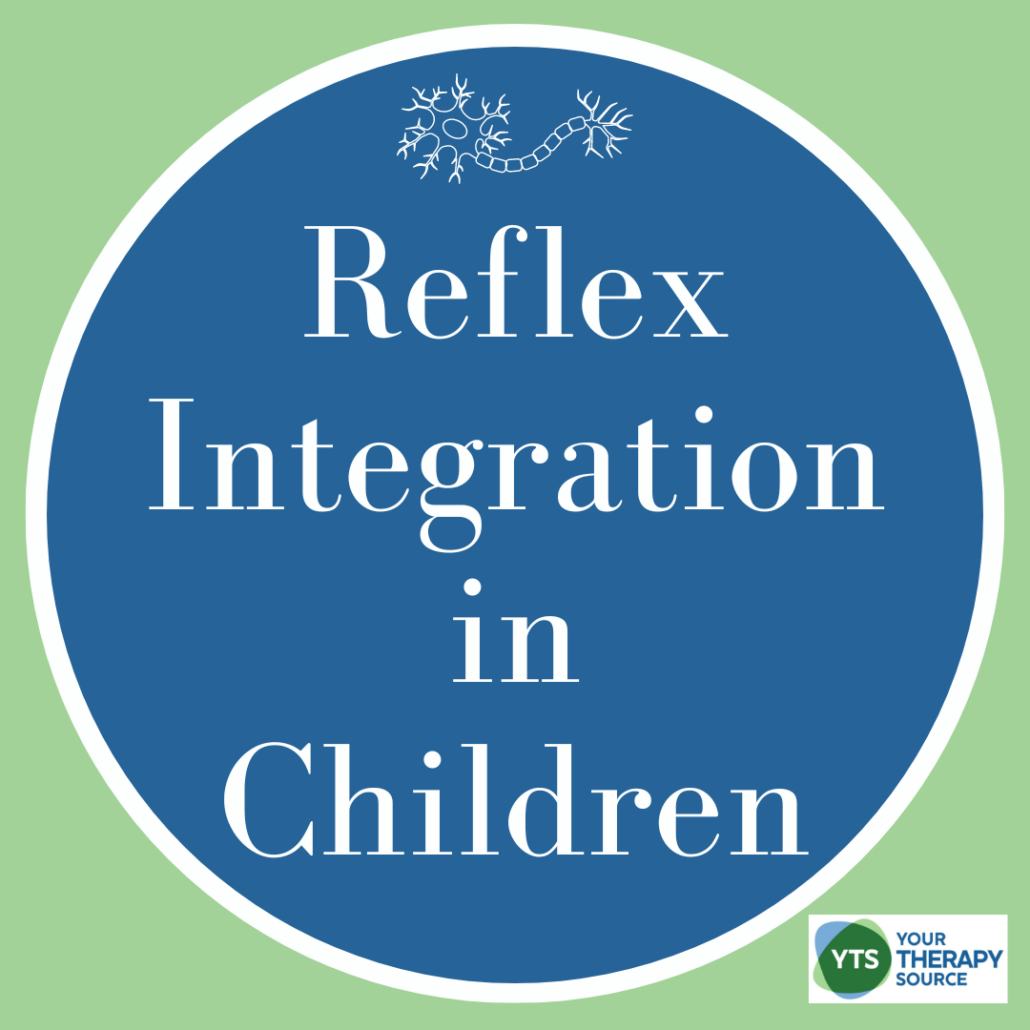Reflex Integration in Children
Every stage of a child’s development presents its unique stages. Reflex integration is one such stage that plays a pivotal role in the early stages of a child’s growth. The journey from an infant’s involuntary movements to a toddler’s mature patterns is fascinating. This process ensures that a child’s interaction with their external environment evolves in sync with their cognitive development.
You can download a FREE handout of this post at the bottom.
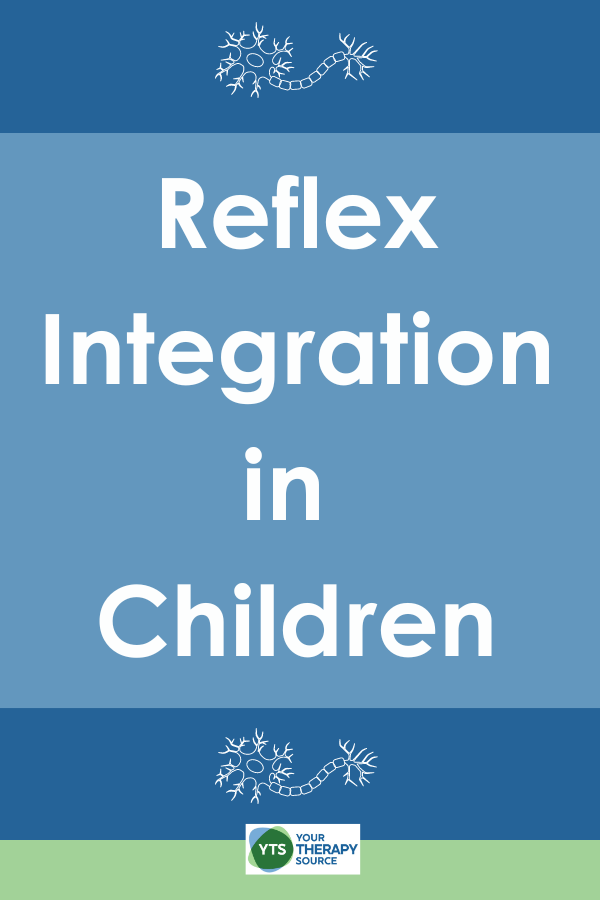
What is Reflex Integration?
Reflex integration refers to the process where primitive reflexes – automatic movements originating from the birth canal during the early months of life – become more integrated or inhibited as a child matures. These reflexes, like the asymmetrical tonic neck reflex and the palmar grasp reflex, are the building blocks of the child’s central nervous system. These reflex patterns should transform over the first year of life, paving the way for voluntary movements. It’s about moving from automatic responses to intentional ones, allowing a child to navigate the world more efficiently.
What is Reflex Integration Treatment?
For those children facing hard times with the retention of primitive reflexes, reflex integration therapy comes as good news. This therapeutic approach, often delivered by skilled occupational therapists, is a non-invasive method designed to stimulate the brain stem, fostering the integration of these reflexes. The therapy incorporates rhythmic movements and other specific exercises. The goal? Achieving normal movement patterns and bolstering both fine motor skills and gross motor skills, ensuring the child feels confident in their movements.
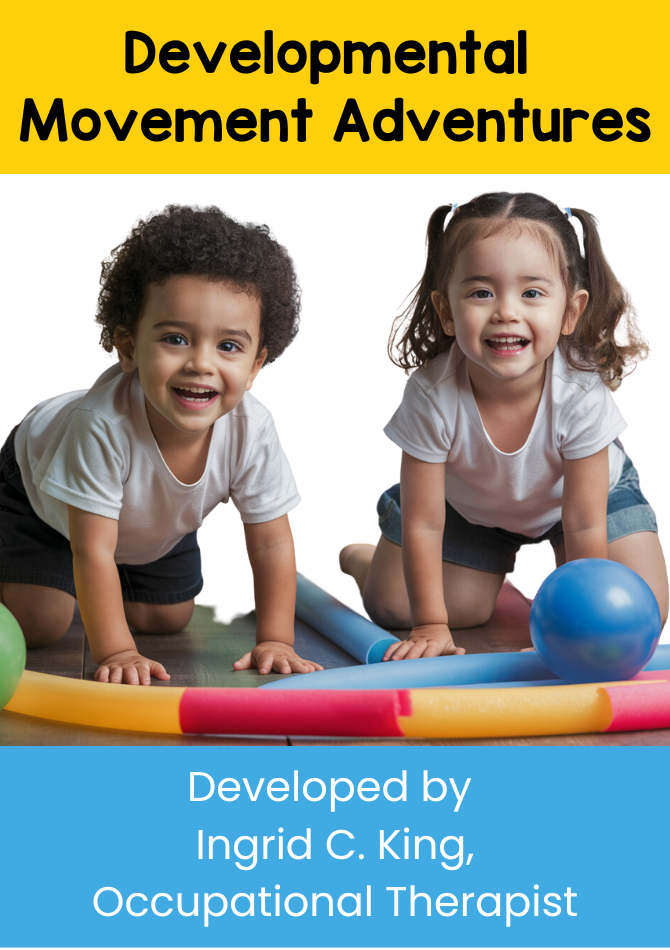
Developmental Movement Adventures
At What Age Should Reflexes Be Integrated?
Typically, reflexes begin their integration process in the first few months of age. By the end of the first year of life, most reflexes, like the retention of the rooting reflex and the spinal galant reflex, should be fully integrated, laying the foundation for mature patterns of response. However, the persistence of primitive reflexes beyond these early stages could indicate potential developmental delays. Early intervention then becomes the key to steering the child back onto the path of normal development.
Examples of When Reflex Integration Occurs
Understanding the typical timeline for reflex integration can provide parents, caregivers, and professionals with a blueprint for what to expect as a child develops. Below are specific developmental timelines for the integration of some commonly observed reflexes in neurotypical children.
1. Moro Reflex
- Appearance: This reflex is often visible immediately after birth.
- Purpose: The Moro reflex, often termed the “startle reflex,” is an automatic response to sudden changes in sensory stimuli. When a baby is startled, they might fling their arms out to the sides and then pull them back in. This reflex prepares the infant to react to potential threats in the environment.
- Typical Integration: In neurotypical children, the Moro reflex usually integrates between 4 to 6 months of age.
2. Symmetrical Tonic Neck Reflex (STNR)
- Appearance: This reflex typically emerges around 6-9 months of age.
- Purpose: The STNR facilitates the development of crawling. When an infant tilts their head backward, the arms straighten and the legs flex, and vice versa. It acts as a precursor to coordinating the upper and lower body.
- Typical Integration: In neurotypical development, the STNR is expected to integrate by 9-11 months of age, although it might persist slightly longer in some children.
3. Asymmetric Tonic Neck Reflex (ATNR)
- Appearance: This reflex can be observed shortly after birth.
- Purpose: Often known as the “fencing reflex”, the ATNR is activated when a baby turns their head to one side. The arm and leg on that side will extend, while the limbs on the opposite side flex. This reflex is crucial for hand-eye coordination and helps prepare the infant for voluntary reaching.
- Typical Integration: The ATNR usually integrates around 6 months of age in neurotypical children.
4. Palmar Grasp Reflex
- Appearance: The Palmar Grasp Reflex is present from birth.
- Purpose: When an object is placed in an infant’s hand and strokes their palm, the fingers will close and they will grasp it. The strength of the grasp can be surprisingly strong, but the baby has no control over holding or releasing the object. This reflex aids in the bonding process and is a precursor to voluntary grasping skills.
- Typical Integration: In neurotypical children, the Palmar Grasp Reflex begins to weaken around 2 to 3 months of age and typically integrates by 6 months.
5. Tonic Labyrinthine Reflex (TLR)
- Appearance: The TLR can be seen from birth.
- Purpose: This reflex is activated by changes in head position concerning gravity. When the baby’s head tilts backward, there is an urge to extend the back, arms, and legs. Conversely, when the head is tilted forward, the body curls in response. The TLR plays a vital role in the development of head control and muscle tone.
- Typical Integration: In neurotypically developing children, the TLR typically integrates by the age of 3 years.
Knowing when these reflexes should typically integrate can offer a valuable point of reference. However, it’s essential to remember that each child’s developmental journey is unique. If parents or caregivers have concerns about persistent reflexes or any other developmental milestones, consulting a pediatrician or occupational therapist can offer guidance and clarity.
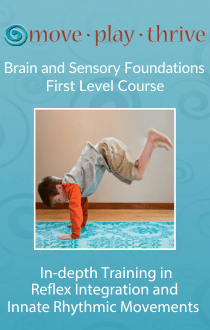
Brain and Sensory Foundations Course
Research Insights on Reflex Retention and Scholastic Performance
A study by Feldhacker et al. (2022) explored the correlation between retained primitive reflexes and scholastic performance among early elementary students. The quantitative correlational study involved 24 kindergartners and 29 first-graders, aged 5–7 years. Researchers screened the children for seven primitive reflexes and assessed their cognitive abilities using the Woodcock–Johnson Test of Cognitive Abilities.
Key findings:
- 100% of participants had at least one retained reflex.
- Most common retained reflexes: Symmetrical Tonic Neck Reflex (STNR) and Asymmetric Tonic Neck Reflex (ATNR).
- Higher prevalence in males: Males showed a higher prevalence of retained reflexes compared to females.
- Correlation: Statistically significant correlation between ATNR retention and poorer scholastic performance in males.
These findings emphasize the importance of considering primitive reflex retention when developing therapy services to support academic achievement.
Another study by Hickey and Feldhacker (2022) examined the relationship between primitive reflex retention and attention in preschool children. This study involved 27 preschool students who were screened for seven primitive reflexes and assessed for attention using the SNAP-IV scale.
Key findings:
- 100% of children had at least one retained reflex, with STNR being the most prevalent.
- Males vs. Females: Males showed higher reflex activity and scored higher on the inattention subtest of the SNAP-IV.
- Significant relationships: A significant correlation between ATNR activity and opposition/defiance, as well as retention of the Moro reflex and inattention.
These studies underscore the need for early screening of primitive reflexes to address potential attention-related issues that could impact a child’s performance in school.
The Role of Primitive Reflex Retention in Handwriting Difficulties
Handwriting is crucial for academic success, but many children struggle with legibility and speed despite training. Research suggests that retained primitive reflexes may contribute to these difficulties, which are not typically addressed in standard interventions.
Key Findings:
- Challenges: Poor handwriting can lead to academic failure and low self-esteem.
- Primitive Reflex Retention: Linked to gross motor deficits, fine motor coordination issues, and poor reading performance.
- Study Results: A study of 74 children (aged 7-9) found a significant correlation between retained reflexes (ATNR, STNR, TLR) and poor handwriting legibility.
Integrating reflex intervention with handwriting instruction may benefit children with retained reflexes. Further research is needed to confirm these findings in larger samples (Richards et al., 2022).
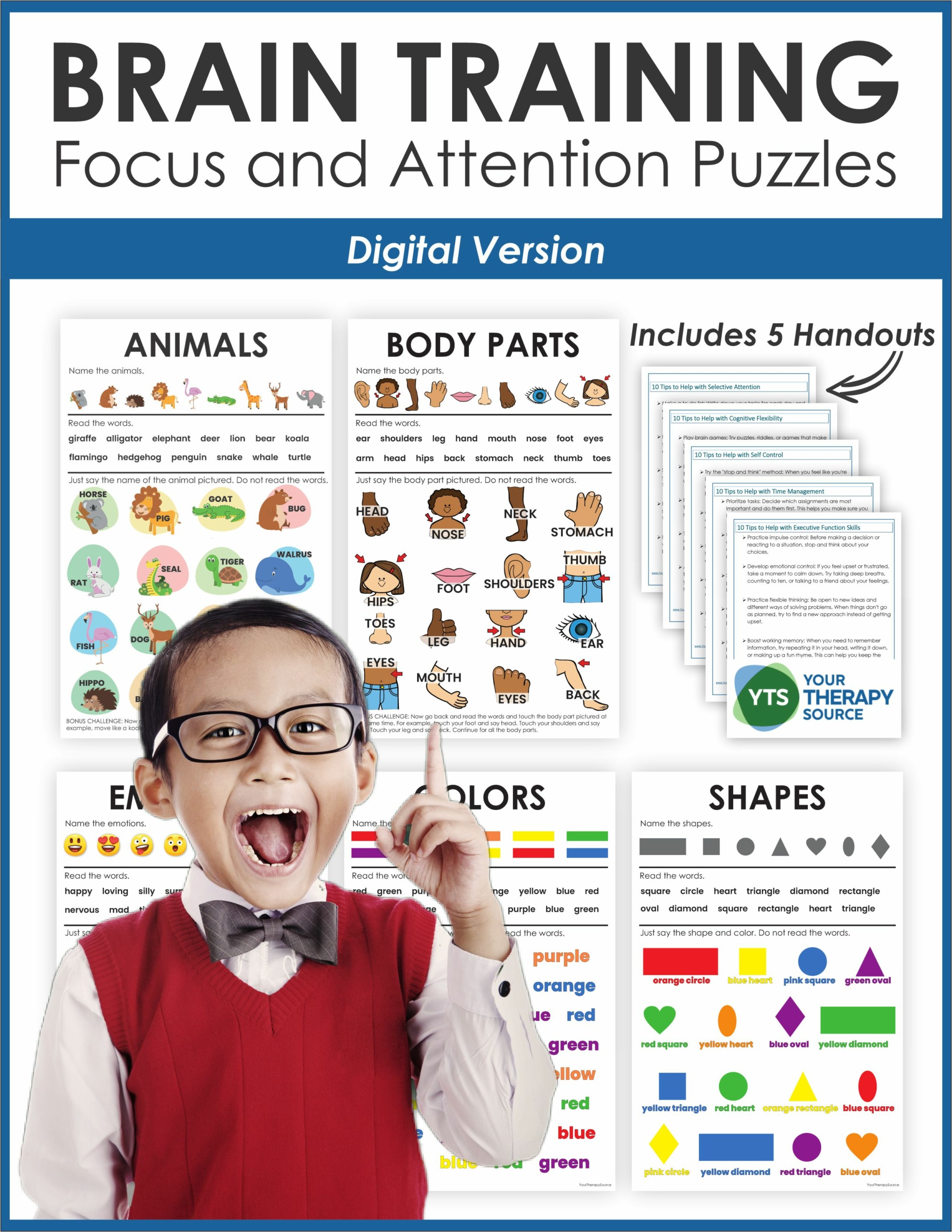
Brain Training Posters DIGITAL Version
The Impact of Retained Reflexes on Psychomotor Development
Primitive reflexes are critical for early brain development, helping to establish neural networks and pathways essential for learning, behavior, and emotional regulation. However, when these reflexes persist beyond the typical age of integration, they can hinder the development of voluntary movements and lead to psychomotor delays.
A study by Gieysztor, Choińska, and Paprocka-Borowicz (2018) focused on the occurrence of primitive reflexes in healthy preschool children and analyzed the impact of retained reflexes on psychomotor development.
Study details:
- Participants: 35 preschool children aged 4-6 years.
- Assessment tools: Sally Goddard primitive reflexes test and the Motor Proficiency Test (MOT 4-6).
- Findings:
- 65% of children had retained primitive reflexes at a residual level.
- The severity of retained reflexes was inversely related to motor efficiency.
- Development categories:
- 9% in “altered development.”
- 29% in “delayed development.”
- 59% in “normal” development.
- 3% in “very good development.”
The study concluded that introducing reflex integration therapy could significantly improve psychomotor development in children with retained reflexes, thereby preventing many of the difficulties they may encounter in social and school settings.
How Do You Assess Reflex Integration?
Trained therapists, often in occupational therapy or physical therapy, use a two-pronged approach to assess reflex integration. First, they evaluate the presence or absence of specific primitive reflexes. Next, they observe the child’s motor responses, muscle tone, and overall coordination. The reflex arc of sensory input provides valuable insights into the child’s reflexive movement patterns. Signs to look for? Poor balance, poor impulse control, atypical movement patterns, and emotional outbursts, especially when faced with a loud noise or sensory stimulus.
What Happens When Reflexes Don’t Integrate?
A non-integrated reflex might seem harmless, but its ripples can have profound impacts. When reflexes remain unconditioned, children may exhibit symptoms like motion sickness, poor hand-eye coordination, and poor posture, which are often rooted in the brain’s inability to integrate sensory inputs efficiently. Persistent reflex movements can possibly hinder cognitive skills and may effect children who have sensory processing disorder or cerebral palsy. Moreover, older children with retained reflexes might face challenges like sensory overload, poor coordination, and even emotional challenges.
Reflex integration is the bridge between involuntary reactions of infancy to the mature, voluntary movements of later childhood. Recognizing its importance and ensuring timely interventions can pave the way for a child’s holistic development, setting them up for success in all life arenas.
Reflex Integration in Children – Key Points
- Essential for Early Development: Primitive reflexes are involuntary movements critical for a newborn’s survival, aiding in feeding, protection, and initiating motor development.
- Transition to Voluntary Movements: As the central nervous system matures, these reflexes should inhibit, allowing for the development of voluntary movements and mature postural reflexes.
- Impact of Retained Reflexes: Failure to integrate these reflexes can contribute to difficulties in areas such as attention, coordination, and learning, potentially complicating conditions like ADHD, autism, and sensory processing challenges.
- Correlation with Academic Challenges: Retained reflexes, like the Asymmetric Tonic Neck Reflex (ATNR) and Symmetrical Tonic Neck Reflex (STNR), are significantly correlated with poor handwriting legibility and scholastic performance.
- Gender Differences: Studies have found that males are more likely to retain primitive reflexes compared to females, affecting their academic performance and attention.
- Role in Psychomotor Development: Retained reflexes can hinder the development of motor efficiency, leading to delays in both gross and fine motor skills.
- Importance of Early Screening: Routine testing of primitive reflexes in preschool and early elementary years can help identify children at risk for developmental delays.
- Intervention Benefits: Integrating reflex intervention with traditional therapies, such as handwriting instruction, may be more effective in addressing challenges related to retained reflexes.
- Developmental Timelines: Reflexes like the Moro, ATNR, STNR, and Tonic Labyrinthine Reflex (TLR) have specific integration timelines, typically within the first year of life, though some persist slightly longer.
- Need for Further Research: While current studies highlight the importance of reflex integration, further research is needed to confirm these findings and improve intervention strategies.
More Information
Need more information? Are you in search of evidence-based resources for OTs on Rhythmic Movement? Sonia Story, who offers the Brain and Sensory Foundations® Program, has put together an AMAZING white paper entitled Evidence for OT Practice.
References
Feldhacker, D. R., Cosgrove, R., Feiten, B., Schmidt, K., & Stewart, M. (2022). The correlation between retained primitive reflexes and scholastic performance among early elementary students. Journal of Occupational Therapy, Schools, & Early Intervention, 15(3), 288-301.
Gieysztor, E. Z., Choińska, A., & Paprocka-Borowicz, M. (2018). Persistence of primitive reflexes and associated motor problems in healthy preschool children. Archives of Medical Science, 14(1), 167-173.
Hickey, J., & Feldhacker, D. R. (2022). Primitive reflex retention and attention among preschool children. Journal of Occupational Therapy, Schools, & Early Intervention, 15(1), 1-13.
Richards, L., Avery, R., Gray, S., & Price, R. (2022). Relationship of Retained Primitive Reflexes and Handwriting Difficulty in Elementary-Age Children. American Journal of Occupational Therapy, 76.
GET YOUR COPY OF THIS POST AS A PRINTABLE HANDOUT
